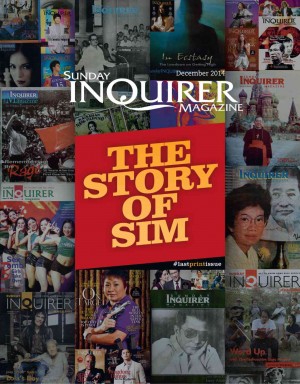TO write “30” in the journalism racket is to end the story.
Old-school news reporters used to end their dispatches by typing three X’s: “30” being the Arabic equivalent of the Roman number XXX. Since it’s one keystroke less, reporters started the practice of typing “30” to signify the end.
To write “30,” by extension, is to be finished, kaput, game over.
Thus, when a crusty old newshound finally joins that great press club in the sky, the headline (on page 2, below the fold) inevitably reads “Editor/reporter/columnist writes ‘30.’”
It is ironic, therefore, that the Sunday Inquirer Magazine ends its current incarnation as a glossy monthly on its 28th year, two years shy of its 30th. Hah, that means we’ll never write “30”!
The absence of a sense of finality that this suggests is strangely reassuring, even as we in SIM prepare for the transition into the next big thing in content provision, whatever form that may take.
Allow me one last bit of self-indulgence then, in looking back at what—to paraphrase Dewey Cox in “Walk Hard”—has been a beautiful ride, writing-wise.
SIM was on its fifth year when I joined the staff in 1991. Just like the country itself, the publication was entering a period of relative stability and economic prosperity following the turbulence and uncertainty of the 1980s. The mood was upbeat, and SIM reflected that.
The brief for the Sunday magazine had changed little since the first Sunday supplement rolled off the presses sometime in the late 19th century: Unlike the daily paper, the magazine was intended for more leisurely weekend reading. This was before the 24-hour news cycle took hold, when weekends still stood for something. The magazine format was ideal for a long, leisurely read over Sunday morning coffee, or while lounging in the sala after a big Sunday lunch.
The content consisted of a wide range of topics of general interest to readers of dailies, with a longer shelf-life than the on-the-fly reportage that was the stock-in-trade of newspapers. The cherished belief was that readers would hold on to the magazine long after the Sunday paper it had come with had become fish-wrap. (Having grown up in a household where issues of the Sunday magazine were kept, I never really bothered to challenge this belief.)
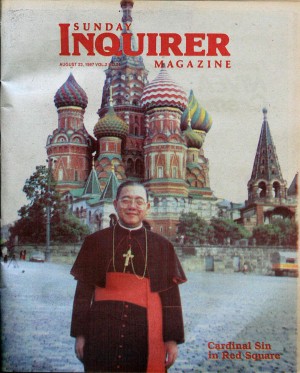 Although it could, and did, include a more in-depth analysis of current events from a wider perspective, the magazine also included interesting features on the personalities of the day, current trends in culture and society, “human interest” stories and miscellaneous items lumped together under the category “stuff women like,” women being presumed to make up the bulk of the magazine’s readership.
Although it could, and did, include a more in-depth analysis of current events from a wider perspective, the magazine also included interesting features on the personalities of the day, current trends in culture and society, “human interest” stories and miscellaneous items lumped together under the category “stuff women like,” women being presumed to make up the bulk of the magazine’s readership.
On the other hand, I as the new kid on the block was also made acutely aware that in its previous six years of existence, SIM had stretched the boundaries of what magazine journalism could be. Cases in point included Ceres P. Doyo’s compassionate portrait of AIDS sufferer Dolzura Cortez (which was made into a movie, starring Vilma Santos no less) and Constantino Tejero’s epic and obsessive explorations of sex in Philippine cinema, which stretched over three, four, sometimes even five issues.
These were large shoes to fill indeed.
My initial months on the staff were spent feeling my way around. Was I to be the pinch-hitter while my more experienced colleagues did the heavy lifting? Or should I carve out my own territory?
Luckily SIM had the ideal editor in Lorna Kalaw Tirol: She allowed each writer the space in which to develop their individual strengths, while reining in their less desirable tendencies, e.g. ponderousness, self-righteousness, literary pretensions, the occasional syntactic lapse.
I wasn’t exactly a novice. I had been a newspaper feature writer for several years, and my previous job had also been as staff writer for a rival Sunday magazine. Before that I had written freelance and for various government agencies and private companies.
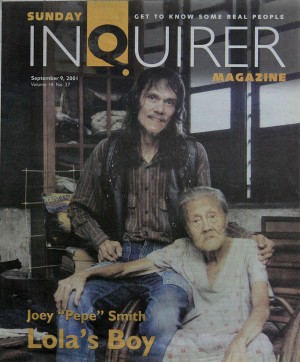
My last years in journalism school coincided with the rise of the so-called “new journalism,” in which writers sought to use literary narrative devices such as dialogue, descriptive passages, interior monologues and story arcs in non-fiction stories. Its major proponents, writers such as Norman Mailer, Gay Talese and Tom Wolfe had applied these techniques to the magazine feature, with spectacularly successful results. Stretched to full length as the “nonfiction novel,” new journalism made the bestseller lists.
Previously, feature writers were low men on the totem pole of the newspaper hierarchy. At the top were “scoop” reporters who broke hard news stories and hard-hitting investigative reports. A rung below were the opinion columnists who developed a loyal following with their take on the news of the day. Editors and copyreaders who kept the whole thing afloat from day to day were somewhere in the middle. Feature writers were way below. They were the first to be cut when ads came in, since their output was basically boilerplate.
The “new” journalism allowed feature writers to become stars in their own right, by dint of their distinctive prose styles and their ability to plug into the zeitgeist.
Closer to home, and some years earlier, Nick Joaquin had also written magazine stories in a prose style that had an evident literary character. Compilations of these stories in book form, including “Reportage on Crime,” “Reportage on Love” and “Nora Aunor and Other Profiles” were published at around the same time.
I was very much under the sway of these writers when I began writing for newspapers again, following the return of a free press in 1986, and the Sunday Inquirer Magazine proved to be the ideal arena for exploring just how far the magazine feature could be taken, specially with the Inquirer’s circulation muscle behind it.
My first few years found me all over the place, profiling Health Secretary Alran Bengzon, sex therapist Margie Holmes, female bodybuilder Donna Dowling, a comebacking Kuh Ledesma, among others. My travel stories took me off the beaten track, to Basilan to profile the Yakan (just in time to witness a shootout between feuding clans), further to the Turtle Islands to witness a pawikan lay her eggs, to a tour of Jolo with a Marine escort. When no interesting destination presented itself we made one up: One of my more memorable outings had me traveling from Manila to Davao by bus, a bone-rattling 48-hour ordeal that I swore never to repeat again.
Over time, a magazine develops a personality of its own: an amalgamation of the personal beliefs, values, prejudices, the character quirks of the people running it, and the people who are presumed to be reading it.
The Sunday Inquirer Magazine was no different.
It tended to be high-minded, politically-correct, with pronounced left-liberal tendencies. Culturally it tended to be middle-of-the-road, not exactly conservative but not too cutting-edge either. In short, it reflected the outlook of the educated, post-Edsa middle class.
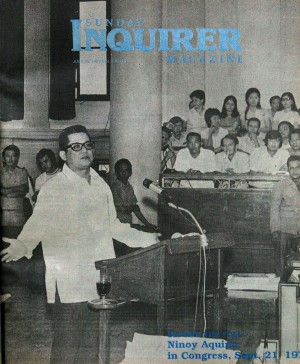 But SIM also prided itself on being more tuned in to contemporary social reality than its competitors, hence we were first to spot and feature emerging trends, such as the emergence of the so-called “nurturing male” epitomized by the house-husband phenomenon, the “new age” movement which ranged from ancient spiritual practices such as yoga and meditation to then-fringe beliefs such as crystal healing and feng shui, the rise of electronic dance music, club culture and the concomitant popularity of Ecstasy, and body modification in the form of tattooing and piercing as an increasingly mainstream form of self-expression.
But SIM also prided itself on being more tuned in to contemporary social reality than its competitors, hence we were first to spot and feature emerging trends, such as the emergence of the so-called “nurturing male” epitomized by the house-husband phenomenon, the “new age” movement which ranged from ancient spiritual practices such as yoga and meditation to then-fringe beliefs such as crystal healing and feng shui, the rise of electronic dance music, club culture and the concomitant popularity of Ecstasy, and body modification in the form of tattooing and piercing as an increasingly mainstream form of self-expression.
I really hit my stride as a writer with SIM’s coverage of the local music scene.
I had been a record reviewer for Jingle magazine in the mid-1980s. When I started working for newspapers in 1986, among the first stories I wrote were features on the underground hardcore punk rock scene. At the time, the punks were the tabloids’ latest boogeymen, portrayed as devil-worshipping drug addicts and possibly sexual deviants.
I viewed them as a harbingers of a genuine cultural movement, which would come to fruition several years later with the emergence of the so-called “alternative” rock scene, as epitomized by the Eraserheads.
I had been covering the local music scene as a matter of course, writing about the emergence of then new artists such as Joey Ayala from Davao and the Blank band from Baguio with its lead singer Grace Nono. I had also been on hand to witness multiple comebacks (and stumbles) from veteran rockers such as Joey “Pepe” Smith and Mike Hanopol. Over the years I witnessed how artists evolve and mutate, from new wave outfit Dean’s December to Binky Lampano’s jazz-blues inflected Newly Industrialized Combo; from hardcore punks The Betrayed to The Skavengers and Tropical Depression, from The Urban Bandits to Put3Ska.
But nothing prepared me for the sui generis phenomenon that was the Eraserheads, four dorm kids from UP Diliman who would change not just the underground music scene, but the entire music industry in just a few short years. There was so much excitement generated by these bands that I managed to pigeonhole myself as a “music writer.” Eventually these dispatches from the moshpits of clubs such as the Roxy, Red Rocks and Club Dredd formed the bulk of my first book, “Punks, Poets, Poseurs: Reportage on Pinoy Rock & Roll,” thanks to the indulgence of my editors, who let me run with the ball despite occasional misgivings.
Meanwhile, SIM continued to evolve as the ’90s gave way to the Oughts. In the interim, the mothership had changed hands, and this was reflected in a similar changing of the guard at the magazine. Succeeding editors gave their individual stamp to the character of the magazine. Before Kalaw-Tirol, there were Letty Jimenez-Magsanoc (now Inquirer editor in chief), sports editor Recah Trinidad and entertainment columnist Nestor Torre. The mid-’90s saw Alya Honasan and Pennie Azarcon-de la Cruz taking over as editors, while publishers Karla Delgado and Leica Carpo (now Argosino) took care of the business side.
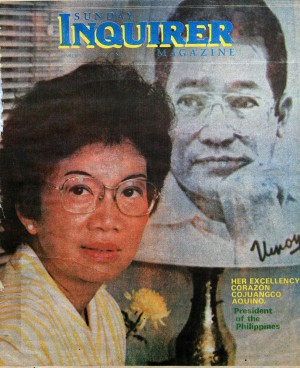 Readers’ tastes had also evolved over the years, and as the cult of celebrity became a more prominent feature of Filipinos’ daily lives, SIM became more people-oriented. Its new slogan was “get to know some real people,” and the “personality profile,” as it used to be called, was raised to a high art.
Readers’ tastes had also evolved over the years, and as the cult of celebrity became a more prominent feature of Filipinos’ daily lives, SIM became more people-oriented. Its new slogan was “get to know some real people,” and the “personality profile,” as it used to be called, was raised to a high art.
But even here SIM kept its quirks and idiosyncracies. Apart from featuring various newsmakers, celebrities and flavors-of-the-week, we made sure to also give praise to the unsung—people who had made an actual difference in their fields but had somehow never gotten their due. We also sought out the lost and the forgotten. We were equal-opportunity flacks: Everyone had an interesting story to tell, if you dug deep enough.
Among others I profiled Dr. Jesus Lava, the last of the founders of the Partido Komunista ng Pilipinas, then already in his late 80s; Pepe Smith’s grandmother, who had raised him from boyhood in Kamuning; B-movie mogul Cirio Santiago; and former radio jock Howlin’ Dave, who was then languishing in the wilds of Novaliches but still burning with the unquenchable rock ’n’ roll flame. I also got to meet some of my culture heroes: photographer Mary Ellen Mark, when she was a guest of painter Bencab in Baguio, and New York noise band Sonic Youth, when they played the Araneta Coliseum.
Fringe personalities also found themselves in SIM’s pages, with two of them being editor Azarcon-dela Cruz’s favorite reads: my profile stories on Bugs Bunny and WengWeng, that foot-tall karate-wielding spoof version of James Bond and the oily Tony Ferrer of Agent X-44 infamy.
SIM was also experimenting with “theme” issues: devoting most if not all the stories in a certain issue to a central theme, whether it be love (usually in February), the martial law hangover (September), or education (June). When summer rolled around, we usually took the high road with our regular summer reading issue, although from time to time we also allowed ourselves a swimsuit cover.
The advent of the digital age posed new challenges for the magazine. Now we were competing not only with other weekly publications, but also for the increasingly short attention spans of readers for whom the Internet, not print media, was the primary source of information and entertainment. This resulted in an increased focus on photography and graphic design, as the emergence of glossy monthlies in the newsstands considerably upped the ante in this area. (Eventually, we too became a glossy monthly, the last in a succession of format changes that, over the years, saw us becoming a black-and-white weekly, an 8-page broadsheet, and a back to full-color weekly.)
Of course, no one is exempt from the evolve-or-die imperative. Over the years it became evident that the print format had been becoming less and less sustainable in a mediated reality that was becoming more paperless. The nostalgia value of the aroma of printer’s ink on paper notwithstanding, the logic of allowing forests to regenerate while finding other arenas for our words and pictures is, in a word, inescapable.
But no worries—you will be reading us again, only not in the form that you have known, and hopefully, loved, as “the Sunday Inquirer Magazine.”
Until then… •


